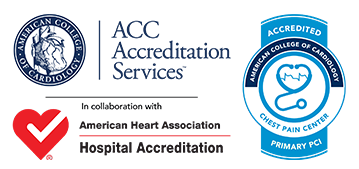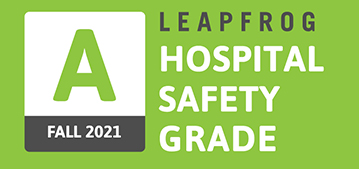Heart and Vascular Procedures
Click below for a detailed list of the procedures we offer.
Before a Cardiac Catherization Procedure
- Bring a list of current medications with you to the hospital. Tell your doctor what medicines you take and about any allergies you have.
- You may shower.
- Don’t eat or drink anything after midnight, the night before the procedure (if you are having an am procedure).
- You may have sips of water to take your medications as prescribed by your physician.
- Know that the skin where the catheter will be inserted may be clipped. You may be given medication to relax before the procedure.
- Please call your doctor if you become ill, or there are any changes with your health.
- Please leave money, jewelry and other valuables at home
- If you have any concerns or questions, contact your physician’s office.
Cardiac Catheterization
A cardiac catheterization or angiogram is a procedure that identifies possible problems with the heart or its arteries. During a catheterization, a thin plastic tube, called a catheter, is inserted into a blood vessel in the groin or arm. The catheter is guided up toward the heart. A special dye is injected into the catheter so x-rays can identify any artery blockage or other heart problems. This comprehensive test shows narrowing in the arteries, overall heart size and pumping ability of the heart. If a narrowing of a heart artery is found, this can usually be treated with balloon angioplasty and stenting, including the drug coated stents. This is usually performed on an outpatient basis with an overnight stay needed after an angioplasty or stenting.
Minimally invasive treatments include;
Balloon Angioplasty- PTCA
Angioplasty is the technique of mechanically widening narrowed or obstructed arteries, the latter typically being a result of atherosclerosis. An empty and collapsed balloon on a guide wire, known as a balloon catheter, is passed into the narrowed locations and then inflated to a fixed size using water pressures some 75 to 500 times normal blood pressure (6 to 20 atmospheres). The balloon crushes the fatty deposits, opening up the blood vessel for the improved flow, and the balloon is then deflated and withdrawn. A stent may or may not be inserted at the time of ballooning to ensure the vessel remains open.
Coronary Stents
Bare Metal Stents
A bare metal stent (BMS) is a coronary stent (a scaffold) placed into narrowed, diseased coronary arteries that slowly releases a drug to block cell proliferation. This prevents fibrosis that, together with clots (thrombus), could otherwise block the stented artery, a process called restenosis. The stent is usually placed within the coronary artery by an Interventional cardiologist during an angioplasty procedure.
Drug-eluting Stents
A drug-eluting stent (DES) is a coronary stent (a scaffold) placed into narrowed, diseased coronary arteries that slowly releases a drug to block cell proliferation. This prevents fibrosis that, together with clots (thrombus), could otherwise block the stented artery, a process called restenosis. The stent is usually placed within the coronary artery by an Interventional cardiologist during an angioplasty procedure.
Electrophysiology (testing and treating of heart rhythm disorders)
Electrophysiology testing involves placing a special catheter in the low pressure side of the heart that relate to the electrical pathway or the conduit of the heart.Mapping is done and patients receive ablation or burning of the specific areas causing irregular heart rhythms to bring them back to a regular heart rhythm.
Permanent Pacemaker
Your doctor has recommended a pacemaker because there are signs that your heart is not beating fast enough or there is a problem with the normal electrical signal which causes your heart to beat. A permanent pacemaker consists of a generator and leads which are usually implanted into the upper chest through a small incision. The generator is a metal case containing the power source and a timer that regulates how often the pacemaker sends out electrical signals. The generator life is usually 7 to 10 years. The leads allow the pacemaker to monitor your heart rhythm and to send out electrical signals to make your heart beat when needed.
Intra-aortic balloon pump
The Intra-aortic balloon pump (IABP) is a mechanical device that increases myocardial oxygen perfusion while at the same time increasing cardiac output. Increasing cardiac output increases coronary blood flow and therefore myocardial oxygen delivery
Internal Cardiac Defibrillators
An AICD is a device that monitors a person’s heart rate. They are generally implanted into heart failure patients. The device is programmed to perform the following tasks; speed up or slow down your heart, depending upon the heart rate. The AICD gives your heart a shock if you start having life threatening arrhythmias or an abnormally high heart rate. Arrhythmias occur when your heart does not beat normally. Some arrhythmias can cause the heart to completely stop beating. The shock given by the AICD can make the heart start beating normally again. An AICD can also make your heart beat faster if your heart is not beating fast enough. There are different kinds of AICDs, but they all have 2 parts: electrodes (thin flexible wires) and a generator. The electrodes or “leads” sense or watch the heart’s electrical activity. The generator is the battery power source and the “brains” of the AICD. It is a small metal can about the size of a deck of cards. The generator stores information about any arrhythmias you have. The generator also keeps track of how often it needs to give your heart a shock. Some AICDs also function as pacemakers for heart rates that are too slow or too fast.
Intravascular Ultrasound
An invasive procedure, performed along with cardiac catheterization; a miniature sound probe (transducer) on the tip of a coronary catheter is threaded through the coronary arteries and, using high-frequency sound waves, produces detailed images of the interior walls of the arteries. Where angiography shows a two-dimensional silhouette of the interior of the coronary arteries, IVUS shows a cross-section of both the interior, and the layers of the artery wall itself.
Left-Ventricular assist device (Impella)
The Impella catheter procedure is an assist device that is placed in the main pumping chamber of the heart to use as an extra help in difficult procedures.It allows patients to have their cardiac output increased to withstand an exam that would otherwise go to the operating room.
PFO Closure (Patent Foramen Ovale)
Atrial septal defect (ASD) is a form of congenital heart defect that enables blood flow between two compartments of the heart called the left and right atria. Normally, the right and left atria are separated by a septum called the interatrial septum. If this septum is defective or absent, then oxygen-rich blood can flow directly from the left side of the heart to mix with the oxygen-poor blood in the right side of the heart, or vice versa. This can lead to lower than normal oxygen levels in the arterial blood that supplies the brain, organs, and tissues. However, an ASD may not produce noticeable signs or symptoms, especially if the defect is small.
Rotational atherectomy
A rotational atherectomy is a type of interventional coronary procedure to help open coronary arteries blocked with more calcified material and restore blood flow to the heart. This procedure utilizes a high speed rotational “burr” that is coated with microscopic diamond particles. It rotates at high speed (approximately 200,000 rpm), breaking up blockages into very small fragments (smaller than red blood cells) which can pass, harmlessly, into the circulation. Often angioplasty/stent is performed after rotational atherectomy to improve the results.
JOINT REPLACEMENT WITH A ROBOTIC ASSIST
Bakersfield Heart Hospitals vascular surgery program uses the most advanced technology, including minimally invasive procedures whenever possible. Medical advancements in catheter-guided technology and imaging means that interventional radiologists, cardiologists and vascular surgeons can treat and diagnose a variety of vascular conditions without surgery. These minimally invasive procedures require only a small incision and are often less risky, produce less pain and result in a faster, easier recovery than surgical procedures.
Minimally invasive treatment options include;
Atherectomy
Atherectomy is a minimally invasive surgical method of removing, mainly, atherosclerosis from a large blood vessel within the body. Today, it is generally used to effectively treat peripheral arterial disease of the lower extremities. Unlike angioplasty and stents, which push plaque into the vessel wall, atherectomy involves removing the plaque burden within the vessel. Increasing the vessel lumen by removing the plaque burden improves downstream wound healing, reduces claudication and pushes amputation levels more distal. While atherectomy is usually employed to treat arteries it can be used in veins and vein grafts as well.
Directional Atherectomy
Directional Coronary Atherectomy (DCA) is a minimally invasive procedure to remove the blockage from the coronary arteries and allow more blood to flow to the heart muscle and ease the pain caused by blockages. The procedure begins with the doctor injecting some local anesthesia into the groin area and putting a needle into the femoral artery, the blood vessel that runs down the leg. A guide wire is placed through the needle and the needle is removed. An introducer is then placed over the guide wire, after which the wire is removed. A different sized guide wire is put in its place. Next, a long narrow tube called a diagnostic catheter is advanced through the introducer over the guide wire, into the blood vessel. This catheter is then guided to the aorta and the guide wire is removed. Once the catheter is placed in the opening or ostium of one of the coronary arteries, the doctor injects dye and takes an x-ray. If a treatable blockage is noted, the first catheter is exchanged for a guiding catheter. Once the guiding catheter is in place, a guide wire is advanced across the blockage, then a catheter designed for lesion cutting is advanced across the blockage site. A low-pressure balloon, which is attached to the catheter adjacent to the cutter, is inflated such that the lesion material is exposed to the cutter. The cutter spins, cutting away pieces of the blockage. These lesion pieces are stored in a section of the catheter called a nosecone, and removed after the intervention is complete. Together with rotation of the catheter, the balloon can be deflated and re-inflated to cut the blockage in any direction, allowing for uniform debulking. A device called a stent may be placed within the coronary artery to keep the vessel open. After the intervention is completed the doctor injects contrast media and takes an x-ray to check for any change in the arteries. Following this, the catheter is removed and the procedure is completed.
Rotational Atherectomy
A rotational atherectomy is a type of interventional coronary procedure to help open coronary arteries blocked with more calcified material and restore blood flow to the heart. This procedure utilizes a high speed rotational “burr” that is coated with microscopic diamond particles. It rotates at high speed (approximately 200,000 rpm), breaking up blockages into very small fragments (smaller than red blood cells) which can pass, harmlessly, into the circulation. Often angioplasty/stent is performed after rotational atherectomy to improve the results.
Carotid Artery Stenting
(CAS) is an endovascular, catheter-based procedure which unblocks narrowings of the carotid artery to prevent a stroke. Carotid artery stenosis (blockage) can present with no symptoms (diagnosed incidentally) or with symptoms such as transient ischemic attacks (TIAs) or cerebrovascular accidents (CVAs, strokes). Hardening of the arteries, also known as atherosclerosis, can cause a build-up of plaque. In hardening of the arteries, plaque builds up in the walls of your arteries as you age. Cholesterol, calcium, and fibrous tissue make up the plaque. As more plaque accumulates, your arteries can narrow and stiffen. Eventually, enough plaque may build up to reduce blood flow through your arteries, or cause blood clots or pieces of plaque to break free and to block the arteries in the brain beyond the plaque. Your carotid arteries are located on each side of your neck and extend from your aorta in your chest to the base of your skull. These arteries supply blood to your brain. You have one main carotid artery on each side, and each of these divides into two major branches, the external and the internal carotid arteries. The external carotid supplies blood to your face and scalp. Your internal carotid artery is more important because it supplies blood to the brain.
IVC filter implantation and removal
In an inferior vena cava filter placement procedure, Interventional Radiologists or Cardiologist use image guidance to place a filter in the inferior vena cava (IVC), the large vein in the abdomen that returns blood from the lower body to the heart. Blood clots that develop in the veins of the leg or pelvis, a condition called deep vein thrombosis (DVT), occasionally break up and large pieces of the clot can travel to the lungs. An IVC filter traps large clot fragments and prevents them from traveling through the vena cava vein to the heart and lungs, where they could cause severe complications or even death. Until recently, IVC filters were available only as permanently implanted devices. Newer filters, called optionally retrievable filters, may be left in place permanently or have the option to potentially be removed from the blood vessel later. This removal may be performed when the risk of clot traveling to the lung has passed. Removal of an IVC filter eliminates any long term risks of having the filter in place. It does not address the cause of the deep vein thrombosis or coagulation. Your referring physician will determine if blood thinners are still necessary. However, not all retrievable IVC filters are able to be retrieved. These filters can be safely left in place as permanent filters.
Peripheral Angioplasty
Peripheral angioplasty refers to the use of a balloon to open a blood vessel outside the coronary arteries. It is commonly done to treat atherosclerotic narrowings of the abdomen, leg and renal(kidney) arteries. PA can also be done to treat narrowings in veins, etc. Often, peripheral angioplasty is used in conjunction with peripheral stenting and atherectomy. Technically, angioplasty can be used to describe any dimensional treatment of blood vessels, whether enlarging, or reducing diameter, depending on requirements to treat the disease.
Peripheral Stenting
Peripheral Stenting is one treatment option for addressing Peripheral Arterial Disease (PAD). PAD refers to the formation of atherosclerotic plaques, or lesions, on the inside of an artery. These plaques are composed of cholesterol, fatty deposits, and other substances. Over time, the plaques increase in size, progressively restricting the flow of blood through the artery. PAD in the arteries of the legs can lead to pain in the legs due to the reduced blood flow. Left untreated, PAD can progress to completely blocking blood vessels, which can lead to ulcers, tissue death, and gangrene.
Temporary Dialysis Catheter placement
If you have kidney disease that has progressed quickly, you may not have time to get a permanent vascular access before you start hemodialysis treatments. You may need to use a venous catheter as a temporary access. A catheter is a tube inserted into a vein in your neck, chest, or leg near the groin. It has two chambers to allow a two-way flow of blood. Once a catheter is placed, needle insertion is not necessary. Catheters are not ideal for permanent access. They can clog, become infected, and cause narrowing of the veins in which they are placed. But if you need to start hemodialysis immediately, a catheter will work for several weeks or months while your permanent access develops.
Thrombolytic Therapy
Thrombolytic therapy is a treatment used to break up dangerous clots inside your blood vessels. To perform this treatment, your physician injects clot-dissolving medications into a blood vessel. In some cases, the medications flow through your bloodstream to the clot. In other cases, your physician guides a long, thin tube, called a catheter, through your blood vessels to the area of the clot. Depending on the circumstances, the tip of the catheter may carry special attachments that break up clots. The catheter then delivers medications or mechanically breaks up the clot. Your blood is normally a liquid that travels smoothly through your arteries and veins. Sometimes, however, blood components, called platelets, can form clumps and, together with other blood components, can cause the blood to gel. This process is called clotting or, more technically, coagulation. This is a normal process that protects you from excessive bleeding from even a minor injury. However, in certain circumstances blood clots can build up inside a blood vessel and block blood flow. At other times, pieces of these clots can break off, travel through your bloodstream, lodge in a blood vessel somewhere else in your body and obstruct normal blood flow. Blood clots in your heart or lungs, for example, can starve the organ and be life threatening. Depending upon the situation, your physician may decide to provide thrombolytic therapy, also called thrombolysis, as an emergency treatment or as a scheduled procedure to dissolve the blood clots. For example, you may receive emergency thrombolysis if you are having a stroke. In some circumstances, if you have DVT or a blocked bypass graft, your physician may schedule thrombolytic therapy for you.
Department & Services
News & Events

Specialty Bakersfield Reaccredited as Chest Pain Center

BHH Receives “A” in Safety
[wpseo_breadcrumb] Your digital COVID vaccine record refers to the details of...

Get Digital Proof of your COVID-19 Vaccine
[wpseo_breadcrumb] Your digital COVID vaccine record refers to the details of...

Updated Visitor Guidelines
[wpseo_breadcrumb]

